

According to a NASA GSFC Fred Espenak web page: "... The periodicity and recurrence of eclipses is governed by the Saros cycle, a period of approximately 6,585.3 days (18 years 11 days 8 hours). ... The Saros arises from a natural harmony between three of the Moon's orbital periods:
One Saros is equal to 223 synodic months. However, 242 draconic months and 239 anomalistic months are also equal to this same period (to within a couple hours)! Any two eclipses separated by one Saros cycle share very similar geometries. They occur at the same node with the Moon at nearly the same distance from Earth and at the same time of year. Because the Saros period is not equal to a whole number of days, its biggest drawback is that subsequent eclipses are visible from different parts of the globe. The extra 1/3 day displacement means that Earth must rotate an additional 8 hours or 120º with each cycle. For solar eclipses, this results in the shifting of each successive eclipse path by 120º westward. Thus, a Saros series returns to about the same geographic region every 3 Saroses (54 years and 34 days). A Saros series doesn't last indefinitely because the various lunar periods are not perfectly commensurate with one another. In particular, the Moon's node shifts eastward by about 0.5º with each cycle. A typical Saros series for a solar eclipse begins when new Moon occurs about 18 degrees east of a node. If the first eclipse occurs at the Moon's descending node, the Moon's umbral shadow will pass 3500 km below Earth and a partial eclipse will be visible from the south polar region. On the following return, the umbra will pass about 300 km closer to Earth and a partial eclipse of slightly larger magnitude will result. After ten or eleven Saros cycles (about 200 years), the first central eclipse will occur near the south pole of Earth. Over the course of the next 950 years, a central eclipse will occur at each Saros but will be displaced northward by an average of 300 km. Halfway through this period, eclipses of long duration will occur near the equator. The last central eclipse of the series will occur near the north pole. The next approximately ten eclipses will be partial with successively smaller magnitudes. Finally, the Saros series will end some 13 centuries after it began at the opposite pole. A typical series may be comprised of 70 to 80 eclipses, about 50 of which are central (i.e. - total or annular). If a Saros series begins near the ascending node, the first eclipse will be partial from the northern polar region and the previous sequence of events is reversed. Since there are two to five solar eclipses every year, there are approximately forty different Saros series in progress at any one time. ...".
Solar:
- 23 November 2003
- 31 May 2003
- 2002 Africa-Australia
- 2002 Pacific
- 2001 North America
- 2001 Africa
- 2000 North America
- 2000 Dragon Year Antarctica
- 1999 Munich-BALKAN
- 1998 Montserrat
- 1997 Mongolia
- 1996 Norway
- 1984 Ga Tech
Lunar:
"... Total Lunar Eclipse of November 09 [2003] ... The second lunar eclipse of the year occurs [ in the middle of Ramadan ] six lunations after the first. ... it is the very last total eclipse of Saros 126. ... The entire eclipse will be visible from Europe and most of Africa as well as the eastern Americas. ...
Total Solar Eclipse of November 23 [2003] ... [ at the end of Ramadan ] ... a total solar eclipse visible from the Southern Hemisphere ... like May's annular eclipse, the November event features a lunar shadow moving in the "wrong" direction. Once again, the explanation lies in the deep southern track of the umbra coupled with the close proximity of the eclipse with winter solstice. As viewed from the Sun's direction, the shadow passes around the "back" side of the pole between Earth's axis of rotation and the terminator. ...".
(picture taken by Stuart Baird in Stornoway, UK, shown on a BBC web page)]...
... is a very unusual annular eclipse which takes place in the Northern Hemisphere ...
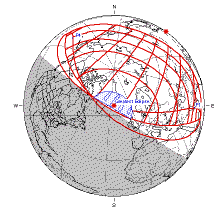
... The axis of the Moon's shadow passes to the far north where it barely grazes Earth's surface. In fact, the northern edge of the antumbra actually misses our planet so that one path limit is defined by the day/night terminator rather by the shadow's upper edge. As a result, the track of annularity has a peculiar "D" shape which is nearly 1200 kilometres wide. Since the eclipse occurs just three weeks prior to the northern summer solstice, Earth's northern axis is pointed sunwards by 21.8°. As seen from the Sun, the antumbral shadow actually passes between the North Pole and the terminator. As a consequence of this extraordinary geometry, the path of annularity runs from east to west instead of visa versa. ...
...[On the preceding full moon of 16 May 2003]... a total lunar eclipse ... occurs just half a day after perigee so the Moon will appear quite large (33.4 arc-minutes). During this event, the Moon is low on the ecliptic in Libra approximately fifteen degrees west of the first magnitude star Alpha Scorpii (Antares). ... The eastern half of North America will witness the entire event, while the partial phases will already be in progress at moonrise from the western portions of the continent. ...".
According to a 16 May 2003 BBC web page: "... Friday, 16 May, 2003, ...[was]... Vesak - the holiest Buddhist festival of the year ... - the festival of lights that honours the birth, death and enlightenment of Buddha ...[in 2003]... Vesak coincides with the 50th anniversary of the climbing of Everest ...

...[the image shows a]... prayer-flag pole ...[being]... raised in Tengboche, Nepal ...".
According to a Cal Poly Pomona web page: "... Probably the most efficient holiday in the calendar is Vesak (also known as Wesak, Visaka, and Visakha). Named after the month in which it occurs, Vesak is held on the full moon day of the fifth month. Vesak celebrates the birth, the enlightenment, and the death of the Buddha. In a sense, the festival is a reminder that the possibility exists for each of us to attain enlightenment. Vesak festival includes paying homage to the Buddha with incense, flowers, candles and food. Visits to temples and sacred sites are commonplace. ...[However, some Buddhists celebrate the full]... moon day of the sixth lunar month ...[as the]... day the Buddha was born, attained enlightenment, and passed away ...[and that day, a month later, is called ... Visakha Puja Day ...[and, further,]... In the Northern [Buddhist] Tradition ...[Buddha's birth, enlightenment, and death are celebrated on three different dates. ...". Perhaps some of these varying dates correspond to different ways to reconcile the solar and lunar aspects of a solar-lunar calendar.
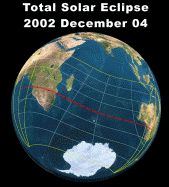
... The path of the Moon's umbral shadow begins in the South Atlantic and crosses southern Africa. After traversing the southern Indian Ocean, the path sweeps through southern Australia where the eclipse ends at sunset. ...".
About two days before 4 December 2002, around the 27th night of Ramadan, is the Night of Power. In the year 2002, the Hebrew month Kislev coincides (roughly, within 2 or 3 days or so) with the Islamic month Ramadan, so that the end of Ramadan occurs during Hanukah, an 8-day period at the end of Kislev through the first 2 or 3 days or so of Tevet. In 2002, the last day of Hanukah (7 December, 2 Tevet) is 2 or 3 days after Ramadan.
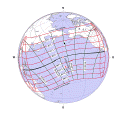
... June's annular path is nearly 14,000 kilometers long, it is only 13 to 78 kilometers wide. The path of annularity is plotted in blue on the global map of the eclipse ... From Asia and the western Pacific, the eclipse actually occurs on June 11 because of the International Date Line ... Greatest eclipse6 occurs at 23:48:15 UT about 2600 kilometers northwest of the Hawaiian Islands. The duration of the annular phase lasts a scant 23 seconds, but the event takes place in open ocean with no landfall in sight. ...". It was member 35 of 70 in Saros Series 137.
About two days before 14 December 2001, around the 27th night of Ramadan, is the Night of Power. In the year 2001, the Hebrew month Kislev coincides (roughly, within 2 or 3 days or so) with the Islamic month Ramadan, so that the end of Ramadan occurs during Hanukah, an 8-day period at the end of Kislev through the first 2 or 3 days or so of Tevet. In 2001, the last day of Hanukah (17 December, 2 Tevet) is 1 or 2 days after Ramadan.
The full moon of the month before Ramadan, the 15th night of Shabaan, is the Night of Record, which is an Islamic holiday similar to Halloween - All Saints Day - All Souls Day. In 2001, the Night of Record falls on the Halloween 31 October 2001 Full Moon (following the 2 October 2001 Harvest Moon). The Halloween 2001 Full Moon, at sunset, looks like

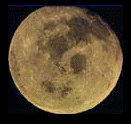
the Great Pumpkin rising from the Pumpkin Patch of the East. The following year, 2002, the New Moon of Ramadan coincides with 1 Kislev 5763, beginning at sunset of 5 November 2002.
According to A Neopagan Druid Calendar, by Isaac Bonewits, the Major High Day of Samhain "... is the original festival that became ... Halloween ... The day before Samhain is the last day of summer (or the old year) and the day after Samhain is the first day of winter (or of the new year). Being "between" seasons or years, Samhain was (and is) considered a very magical time ...".
According to www.holidays.net/halloween/muertos.htm: "... Los Dias de los Muertos, the Days of the Dead, is a traditional Mexico holiday honoring the dead. It is celebrated every year at the same time as Halloween and the Christian holy days of All Saints Day and All Souls Day (November 1st and 2nd). ... The Aztecs believed in an afterlife where the spirits of their dead would return as hummingbirds and butterflies. Even images carved in the ancient Aztec monuments show this belief - the linking the spirits of the dead and the Monarch butterfly. ...

...[image from a Florida Monarch Butterfly web page]...
... Every autumn Monarch Butterflies, which have summered up north in the United States and Canada, return to Mexico for the winter protection of the oyamel fir trees [ which did not prevent the death of 250 million Monarchs in January 2002 ]. The locale inhabitants welcome back the returning butterflies, which they believe bear the spirits of their departed. The spirits to be honored during Los Dias de los Muertos. ...".
On 21 June 2001, the southern hemisphere winter solstice, a total solar eclipse "... begins in the South Atlantic about 400 kilometres southeast of Uruguay ... sweeps across the South Atlantic ... crosses southern Africa [ passing over the southern end of the African Rift Valley ]and Madagascar, and ends at sunset in the Indian Ocean ... A partial eclipse will be seen ...[in]... eastern South America and the southern two thirds of Africa ...".
On 25 December 2000, a partial solar eclipse could be seen in North America.
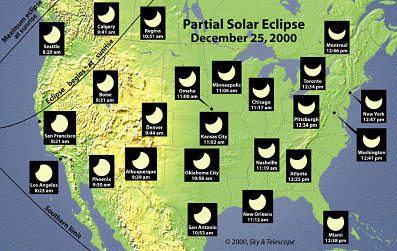
The Julian date of 25 December 2000 - Ganna Christmas - fell on Gregorian 7 January 2001, two days before the
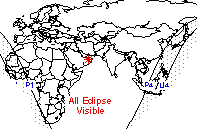
( image from spacescience.com )
of the beginning of the 42 days of Kumbh Mela at the confluence of the Ganga, Yamuna, and Saraswati Rivers near Allahabad, India, where millions of people gather and see a Total Lunar Eclipse near the end of the Year of the Dragon when and where Garuda comes to bring Amrit (nectar). The Amrit had been gathered for Indra by the mountain Mandarachal (the staff), Vishnu (as koorm, tortoise, the base), Brahma (the top), and Vasuki (serpent, the string) acting together to churn the ocean, producing 14 Ratnas (jewels) and Amrit. Garuda, guided by Brihasapati (Jupiter) carried a kumbh (pitcher) of Amrit around the heavens, stopping 4 times (once at the Saraswati-Ganga-Yamuna confluence), and completing a circuit every Jupiter year (about 12 Earth years), so Kumbh Mela is celebrated at the Saraswati-Ganga-Yamuna confluence every 12 years. Every 12th Kumbh Mela (144 year cycle) is a Maha Kumbh Mela, and the 2001 Kumbh Mela is a Maha Kumbh Mela.
On 13 January 2001, four days after the Lunar Eclipse Full Moon of 9 January 2001, there was a 7.6 magnitude Earthquake in El Salvador, antipodal to the mouth of the (now dry) Saraswati River.
Although the following New Moon of 24 January 2001 is not a solar eclipse, it does coincide with the 24 January 2001 end of the Chinese Year of the Metal Dragon. According to the BBC: "... The Maha Kumbh Mela ... sees millions of devotees bathe in the Ganges to purify their sins. ... This extraordinary picture was taken by Space Imaging's Ikonos satellite on Tuesday ...[ 23 January 2001 ]...
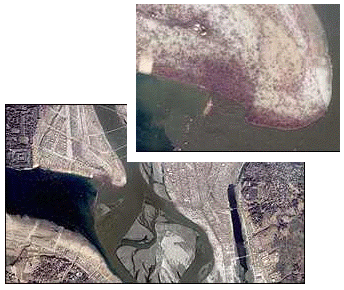
Timed at 1030 am, the image shows what was happening at the start of the most sacred and busiest bathing day (Mauni Amavasya) of the festival. Vast numbers of people are moving down to the waters. ... The festival lasts just over a month. The authorities have spent millions of dollars on security and other arrangements with in excess of 30 million people expected to attend. ...". Shortly afterward, on 26 January 2001,
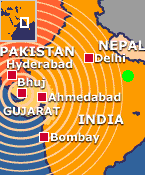
a 7.9 magnitude Earthquake that killed 20,000 people was centered at the mouth of the (now dry) Saraswati River.
After it gets to BALKAN Yugoslavia and Romania, it goes to Bulgaria, passes over the Black Sea, and then through Turkey, Iraq and Iran, and Pakistan and India to the Indian Ocean.
Its Maximum is in BALKAN Romania:
According to the BBC, Wednesday, August 11, 1999: "... Starting off the American coast, the shadow of the Moon raced across the Atlantic at 2,400 kph (1,500 mph). ...
... [CNN carried this EUMETSAT image
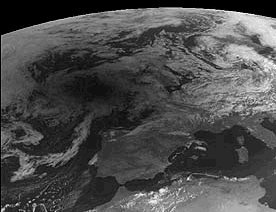
of the shadow] ... A million people had travelled to Cornwall, south-west England, so they could stand in line with the Sun and Moon. ... Joining them in the straight line to the Sun was heavy cloud cover. ... The eclipse as seen from an RAF Hercules at 1025 BST:
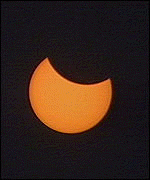
... The eclipse as seen from the RAF Hercules at 1111 BST:
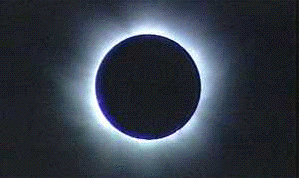
... At 1113BST Cornwall's famous St Michael's Mount disappears into the shadows:
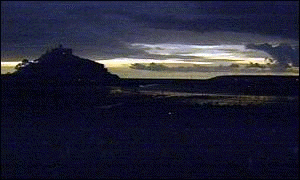
... [The German city of Munich
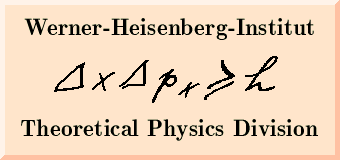
had over two minutes of totality.] ...there were clear skies ... in Munich - right until the moment of totality ... [when] ... heavy rains broke just at the moment of totality, making the event a washout. ...
The streets of Ramnicu Valcea, the south-central city in Romania where totality could be seen the longest, were crammed.
In Egypt, Muslims shut themselves away on the orders of clerics. Others flocked to mosques as earthquakes and an out-of-season hailstorm intensified unease.
... [CNN carried this Diamond-Ring image
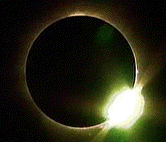
from Diyarbakir, Turkey]
... In some Indian villages, priests rang temple bells and took turns beating steel plates with sticks to ward off evil. But, like Pakistan, cloud cover meant most of India saw the eclipse departing the way it had arrived - obscured.
It finally ended in the Bay of Bengal at 12.36GMT. ...".
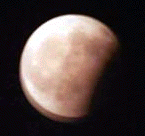
seen from Beijing (image from Xinhua) roughly coincided with the Chinese government declaring Falun Dafa to be illegal.
seen most prominently in North America occurred in Year 5760 at the Full Moon immediately preceding the New Moon of the beginning of the Year of the Dragon.

The image, from the BBC, is of the eclipse as viewed from Londinia, Brazil.
seen in Antarctica occurred in Year 5760 at the New Moon of the beginning of the Year of the Dragon. According to Fred Espenak's eclipse web pages,"... This event is the sixteenth partial eclipse of Saros series 150. The series will produce its first of forty annular eclipses beginning with the year 2126 and continuing for the next seven centuries. ...".
my parents' 44th wedding anniversary, they and I went to the roof of the Physics Building

at Georgia Tech where we saw
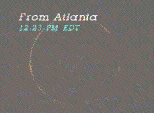
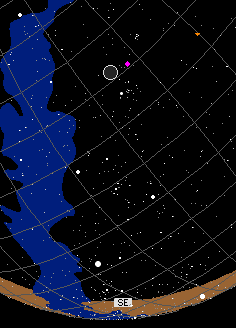
It was member 34 of 70 in Saros Series 137.
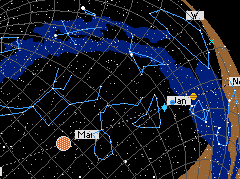
could (except for clouds) be seen from Africa to North America. Then, Comet Hale-Bopp was visible from Atlanta, and Moon was very near Saturn.
The Moon would be near Mars about 6 months later, on 23 March 1997 (local Atlanta time), the time of an umbral lunar eclipse, which coincided with a Falun Dafa seminar by Li Hongzhi in New York City. That lunar eclipse was a day after Comet Hale-Bopp was nearest the Earth, and immediately followed a the total solar eclipse of 9 March 1997.
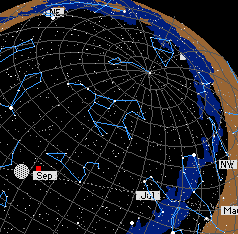
Then, Comet Hale-Bopp would be nearing perihelion, but would be just below the horizon in Atlanta.
The next lunar eclipse, a total one about 16 September 1997, would be visible in Asia but not in Atlanta.
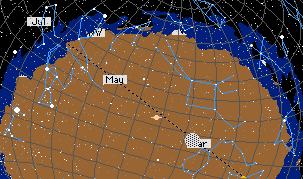
Then the Moon would be about halfway between Saturn and Jupiter.
After that,
the next lunar eclipse visible in Atlanta (which immediately follows the 26 February 1998 Total Solar Eclipse at Montserrat)
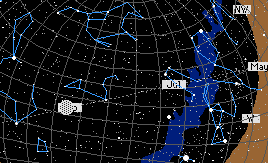
would only be a penumbral eclipse on 13 March 1998, with Neptune, Venus, Uranus, Jupiter, the Sun, Mars, Mercury, and Saturn
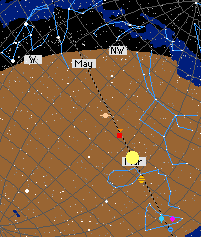
on the Asia side of the Earth.
fully visible in the contiguous United States - a full moon occurs on the same date roughly every 19 years, so a 13 March 1998 full moon means that a full moon occurred at the same date (or within hours of it) in 1979, 1960, 1941, ... .
could be seen in northeastern Canada shortly after sunrise and in Europe and North Africa around sunset. The eclipse was deepest (magnitude 76 percent) just off Norway's North Cape. A few hours after the eclipse, the sun and moon were below the horizon in southern North America.
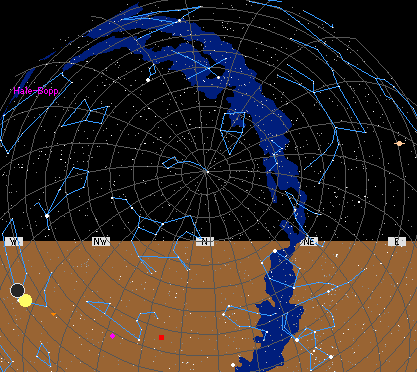
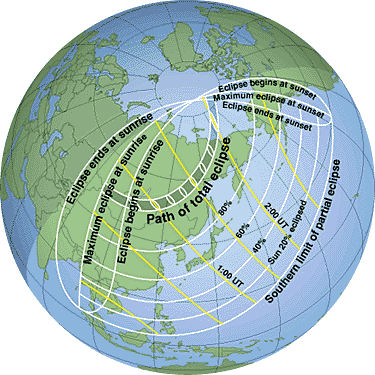
moved from Gora Belukha, 14,783 feet, the highest Altai Mountain, to near the North Pole.
Looking East at dawn on 9 March 1997 from the top of Gora Belukha you would see
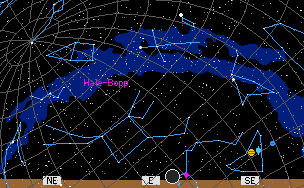
Gora Belukha may be known in China as Kunlun Shan, home of Xi Wang Mu, the Queen of the West, and in India as Su Meru, home of Indra.
THE ORBIT OF EARTH'S MOON is not only such that the angular diameters of the Moon and Sun as seen from Earth are both about half a degree, so that both total and annular eclipses can occur, but is also such that the Moon's gravity stabilizes the tilt of Earth's spin axis to about 23.5 degrees, give or take about 1.3 degrees. If the Moon were not there, the tilt of Earth's spin axis would be unstable and vary from 0 to 85 degrees, according to calculations by Jacques Laskar.
Discover, January 1994 - The Moon of Our Delight by Robert Naeye
The Earth's spin axis precesses around a 23.5 degree cone whose center is at the center of the Earth and whose axis is perpendicular to the plane of Earth's orbit, producing the precession of the equinoxes, a 26,000 year cycle stabilized by the moon and sun.
Gravitational interaction between the Moon and the Earth not only stabilizes the tilt of Earth's spin axis, it also produces tides in Earth's oceans. Since the Earth rotates about 28 times faster than the Moon orbits the Earth, the tidal bulge of the Earth's oceans precedes the Moon's position, and pulls the Moon into a faster and higher orbit. The Moon will continue to recede from the Earth (by about 4 cm/year) until the lunar month equals the solar Earth day, and the tidal bulge is always directly below the Moon. (Universe, by Kaufmann, Freeman 1994)
The Earth's gravitational field can be measured by artificial satellites accurately enough to indicate the general topography of the ocean floor.
Discover, March 1996 - The Seafloor from Space by Robert Kunzig
The Earth's crust is affected by the Moon's gravity from above, and from below by the mantle, the outer core, and the inner core.
According to a Pittsburgh Supercomputing Center web page:
"... There's a giant crystal buried deep within the Earth, at the very center, more than 3,000 miles down. ...... Earth's solid-iron inner core is "anisotropic" -- it has a directional quality, a texture similar to the grain in wood, that allows sound waves to go faster when they travel in a certain direction. ... at the inner core, the pressure is so great -- 3.5 million times surface pressure -- that iron solidifies, even though the temperature is believed to exceed 11,000 degrees Fahrenheit, hotter than the surface of the sun. ...
... calculations showed ... bcc iron is unstable at high pressure and not likely to exist in the inner core. For the other two candidates, fcc and hcp, Stixrude and Cohen found that both can exist at high pressure and both would be directional (anisotropic) in how they transmit sound. Hcp iron, however, gives a better fit with the seismic data. All this was new information, but even more surprising was this: To fit the observed anisotropy, the grain-like texture of the inner core had to be much more pronounced than previously thought. ... If all the crystals must point in the same direction, why not one big crystal? The results, published in Science, offer the simplest, most convincing explanation yet put forward for the observed seismic data ...".
According to a 2 October 2002 BC article:
"... there is evidence of another, smaller, corehidden within ... the Earth's inner core ... The inner core ... is solid, about 2,440 km across, and composed mainly of iron and nickel. ... the shock-waves from earthquakes on one side of the world were measured by sensors on the opposite surface. ... a wave travelling from north to south moved faster than one going east to west. It is believed that this effect happens because the core has been formed in a crystalline manner ... The latest research, published in the Proceedings of the National Academy of Sciences (PNAS), found that a wave precisely targeted through the inner core behaved differently depending on which part of the core it travelled through. There appeared to be a separate "inner inner" core - perhaps 600 km in diameter. Not only was the anisotropy effect much stronger - suggesting an even more crystalline composition - but the angle of most resistance, a guide to the alignment of these crystals, was different to that of the rest of the inner core. ... this difference may be the result of changes in the environment of the core during its formation. ...".
The anisotropic hexagonal close-packed structure of the Earth's solid iron crystal inner core may explain seismic and geomagnetic phenomena.
Differential rotation of the solid iron inner core and fluid outer core may partially explain movement of the Earth's magnetic poles.
The path of the Earth's poles during excursions and reversals seems to be related to Schumann resonances.
The Earth's magnetic field has been weakening for 2,000 years, which may indicate another excursion or reversal is coming.
Eclipses happen on Jupiter, too - 10 Nov 97.
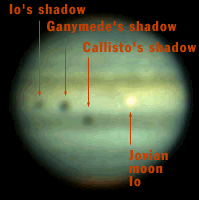
(Jupiter image from ABCNEWS.com, by Kenneth Chang (25 Feb 98))
......